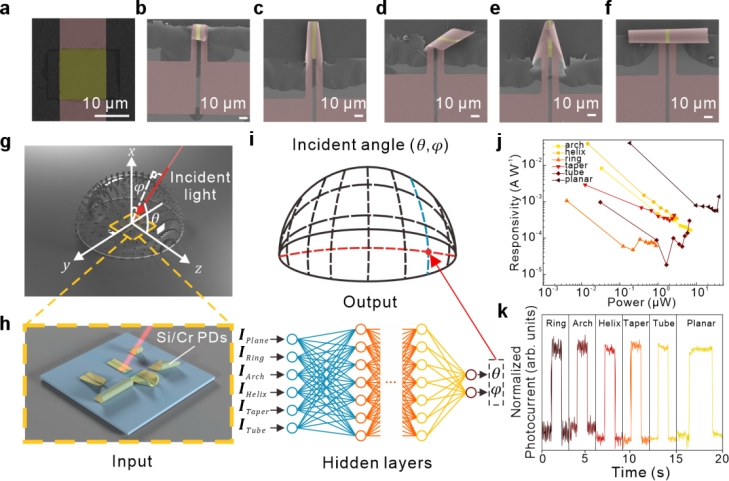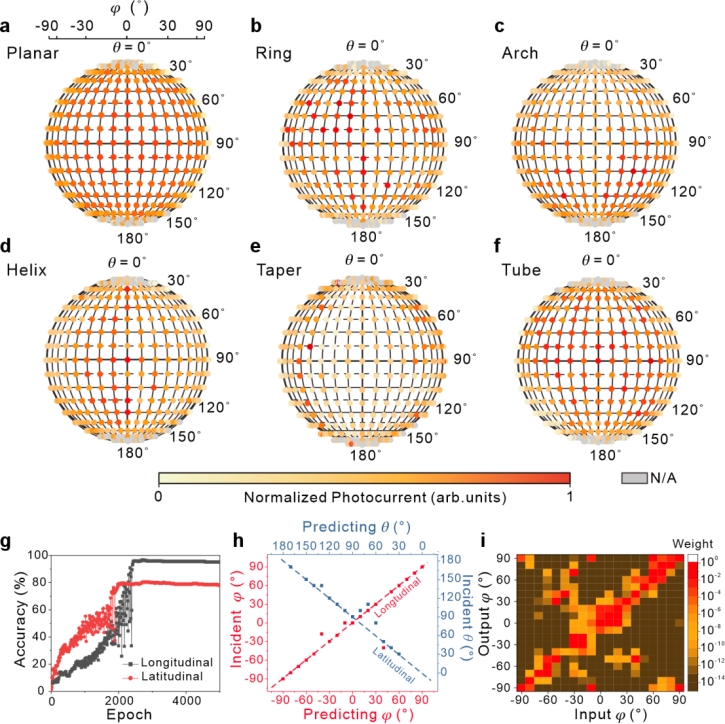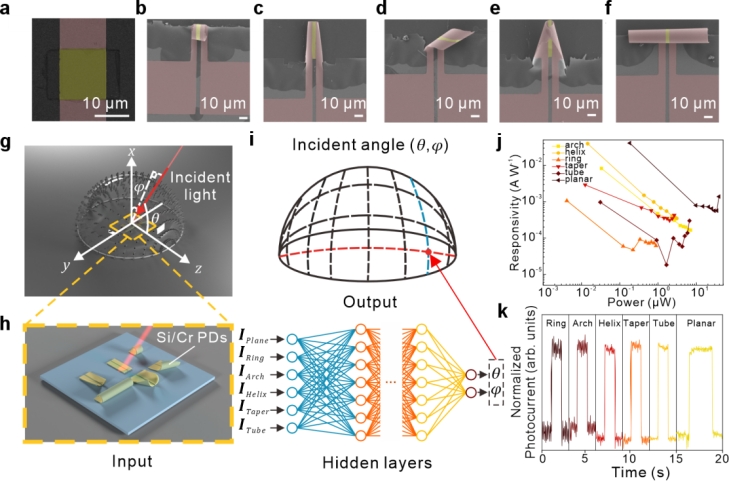光的方向探测对于各类设备的空间定位至关重要,其在航空航天、智能驾驶及智慧机器人等领域具有重要意义。目前常见的角度探测通常由机械激光扫描系统与CMOS光电子阵列技术实现,然而机械激光扫描系统体积庞大,对结构装配精度要求高,CMOS光电子阵列器件中各类探测元件设计困难,制备工艺复杂,使得方向探测的进一步应用受到限制。随着器件小型化和智能化的发展要求,基于片上集成微结构的入射光角度探测对于未来的先进电子器件及其光电应用及其重要,可为三维光空间定位设计提供一类高效率、低成本的探测技术。
近日,复旦大学材料科学系梅永丰教授课题组在《自然通讯》(Nature Communications)上发表题为《用于三维角度光电探测的自卷曲纳米薄膜结构设计与组装》(“Multilevel design and construction in nanomembrane rolling for three-dimensional angle-sensitive photodetection”)的研究工作。博士研究生张子煜与吴斌民博士为共同第一作者,梅永丰教授为通讯作者。

图1 (a)平面,(b)环状,(c)拱状,(d)螺旋形,(e)锥形与(f)管状光探测器。(g)三维入射光角度控制装置与位于其中心的(h)纳米薄膜组装结构光探测器示意图。(i)神经网络辅助的三维入射光空间定位示意图。三维光探测器的(j)响应率与(k)响应时间。
研究团队提出了多级准静态有限元分析法,并基于此设计构筑了六类硅/铬纳米薄膜组装三维微结构及相应的三维光探测器(图1(a)-(f))。团队提出利用不同结构的三维光探测器,结合深度神经网络算法分析各探测器对不同方位的入射光响应,实现对入射光的三维方位探测(图1(g)-(i))。研究表明,纳米薄膜三维结构光探测器在可见光范围内具有良好的光电响应以及亚毫秒级的响应时间(图1(j)-(k)),足以支持神经网络算法中光探测数据集的构建。

图2 (a)平面,(b)环状,(c)拱状,(d)螺旋形,(e)锥形与(f)管状光探测器的三维入射光响应。(g)深度神经网络在三维空间经度与纬度方向的训练集识别精确率。(h)在经度(![]() = 0°)和纬度(
= 0°)和纬度(![]() = 40°)方向上的入射角的角度识别。(i)在经度(
= 40°)方向上的入射角的角度识别。(i)在经度(![]() = 0°)方向上的入射角权重分布图。
= 0°)方向上的入射角权重分布图。
各类微结构光电探测器均展示出对入射光角度的选择性,并将每个入射方位的光电响应作为一组数据用于神经网络的学习(图2(a)-(f))。研究团队对每个光电探测器收集了275个入射点的数据,进行了三维空间入射光光电响应数据库的构建。利用深度神经网络对经度与纬度数据集的训练分别展示出了95%与78%的精确度(图2(g))。基于上述技术可以分别在入射光方向的经度与纬度探测上实现83%与71%的精确度,入射光角度分辨率达到~10°,(图2(h))且角度预测权重显著(图2(i))。
综上所述,结合深度神经网络及纳米薄膜组装三维光探测器可以实现对入射光角度的精准分析。该技术具有良好的应用潜力,并为未来的光电子、微机电系统和微机器人设计提供了一类有效方法。
该工作得到了国家重点研发计划、国家自然科学基金、上海市科委等项目的资助和支持,部分实验在复旦大学微纳加工与器件公共实验室开展。
文章信息:
Ziyu Zhang#, Binmin Wu#, Yang Wang, Tianjun Cai, Mingze Ma, Chunyu You, Chang Liu, Guobang Jiang, Yuhang Hu, Xing Li, Xiang-Zhong Chen, Enming Song, Jizhai Cui, Gaoshan Huang, Suwit Kiravittaya, Yongfeng Mei*. Multilevel design and construction in nanomembrane rolling for threedimensional angle-sensitive photodetection. Nature Communications, 2024, 15, 3066.
文章链接:
https://www.nature.com/articles/s41467-024-47405-2
Multilevel design and construction in nanomembrane rolling for threedimensional angle-sensitive photodetection
The direction detection of light is crucial for the spatial positioning of various types of equipment, and is of great significance in the fields of aerospace, intelligent driving, and intelligent robots. At present, common angle detection is usually realized by mechanical laser scanning system and CMOS optoelectronic array technology. However, the mechanical laser scanning system is bulky and requires high structural assembly accuracy. It is difficult to design various detection elements in CMOS optoelectronic array devices and the preparation process is complex, making Further applications of direction detection are limited. With the development requirements of device miniaturization and intelligence, incident light angle detection based on on-chip integrated microstructures is extremely important for future advanced electronic devices and their optoelectronic applications. It can provide a high-efficiency, low-efficiency, low-efficiency, and low-efficiency method for three-dimensional optical spatial positioning design. cost detection technology.
Recently, the research group of Professor Yongfeng Mei from the Department of Materials Science of Fudan University published an article in Nature Communications entitled Multilevel design and construction in nanomembrane rolling for threedimensional angle-sensitive photodetection. Doctoral student Ziyu Zhang and Dr. Binmin Wu are the co-first authors, and Yongfeng Mei is the corresponding author.

Figure 1 (a) Plane, (b) ring, (c) arch, (d) spiral, (e) cone and (f) tube photodetector. (g) Schematic diagram of the three-dimensional incident light angle control device and (h) nanomembrane assembly structure light detector located in its center. (i) Schematic diagram of neural network-assisted three-dimensional incident light spatial positioning. (j) response rate and (k) response time of three-dimensional photodetector.
The research team proposed a multi-level quasi-static finite element analysis method, and based on this design, six types of silicon/chromium nanomembrane assembly three-dimensional microstructures and corresponding three-dimensional light detectors were constructed (Figure 1(a)-(f)). The team proposed to use three-dimensional light detectors with different structures, combined with deep neural network algorithms to analyze the response of each detector to incident light in different directions, to achieve three-dimensional azimuth detection of incident light (Figure 1(g)-(i)). Research shows that the nanomembrane three-dimensional structured light detector has good photoelectric response and sub-millisecond response time in the visible light range (Figure 1(j)-(k)), which is sufficient to support the construction of light detection data sets in neural network algorithms.
.
Figure 2 Three-dimensional incident light response of (a) plane, (b) ring, (c) arch, (d) spiral, (e) cone and (f) tube photodetector. (g) The training set recognition accuracy of the deep neural network in the longitude and latitude directions of three-dimensional space. (h) Angle identification of the angle of incidence in the longitude (![]() = 0°) and latitude (
= 0°) and latitude (![]() = 40°) directions. (i) Incident angle weight distribution diagram in the longitude (
= 40°) directions. (i) Incident angle weight distribution diagram in the longitude (![]() = 0°) direction.
= 0°) direction.
All types of microstructured photodetectors show selectivity to the angle of incident light, and the photoelectric response of each incident direction is used as a set of data for neural network learning (Figure 2(a)-(f)). The research team collected data from 275 incident points for each photodetector and constructed a three-dimensional incident light photoresponse database. Training on the longitude and latitude data sets using deep neural networks demonstrated 95% and 78% accuracy respectively (Figure 2(g)). Based on the above technology, 83% and 71% accuracy can be achieved respectively in the longitude and latitude detection of the incident light direction. The incident light angle resolution reaches ~10°(Figure 2(h)), and the angle prediction weight is significant (Figure 2(i)).
In summary, combining deep neural networks and nanomembranes to assemble a three-dimensional light detector can achieve accurate analysis of the incident light angle. This technology has good application potential and provides an effective method for future optoelectronics, microelectromechanical systems and microrobotics design.
This work was funded and supported by the National Key R&D Program, the National Natural Science Foundation, the Shanghai Science and Technology Commission and other projects. Parts of experiments were carried out in the Micro-Nano Processing and Device Public Laboratory of Fudan University.
Article information:
Ziyu Zhang#, Binmin Wu#, Yang Wang, Tianjun Cai, Mingze Ma, Chunyu You, Chang Liu, Guobang Jiang, Yuhang Hu, Xing Li, Xiang-Zhong Chen, Enming Song, Jizhai Cui, Gaoshan Huang, Suwit Kiravittaya, Yongfeng Mei*. Multilevel design and construction in nanomembrane rolling for three-dimensional angle-sensitive photodetection. Nature Communications, 2024, 15, 3066.
Article link:
https://www.nature.com/articles/s41467-024-47405-2
